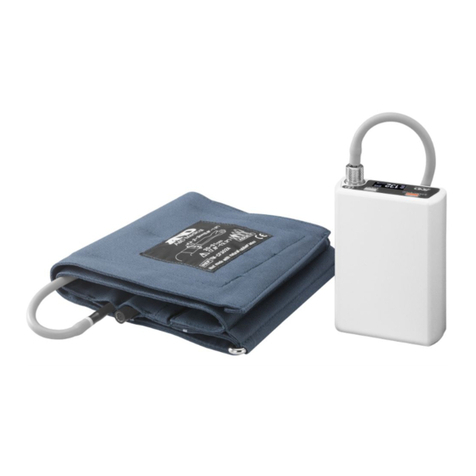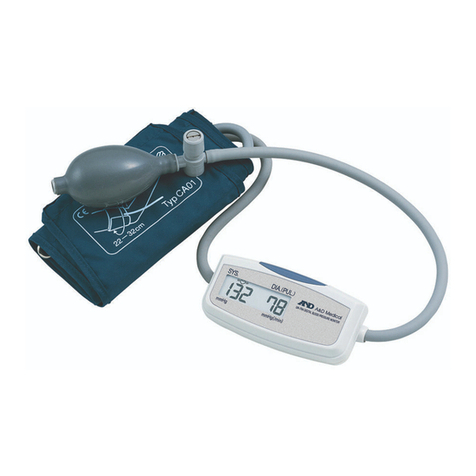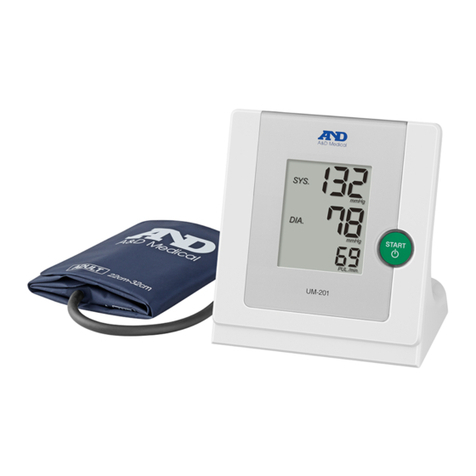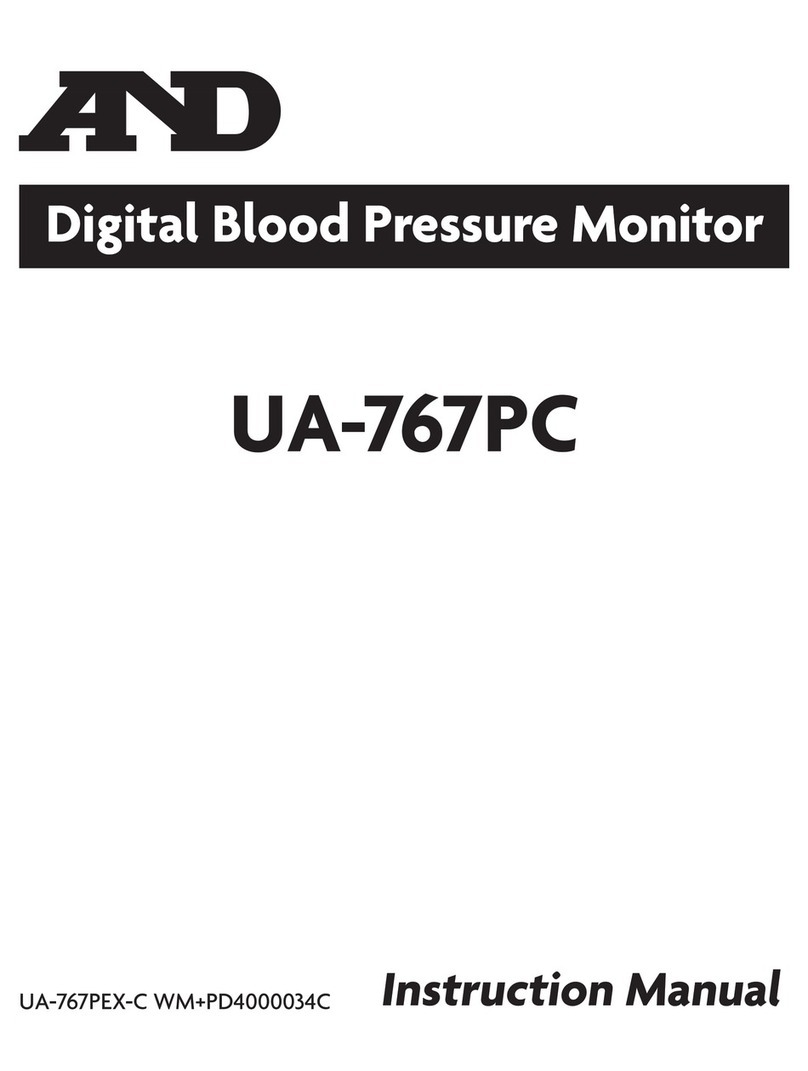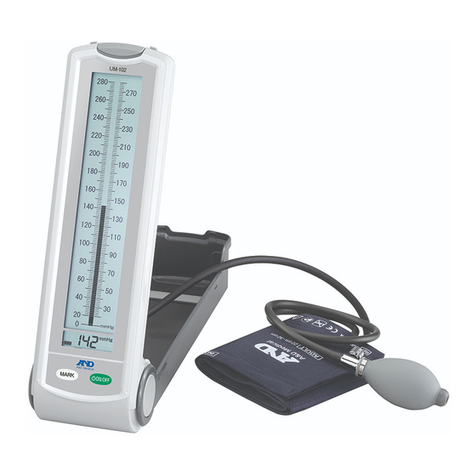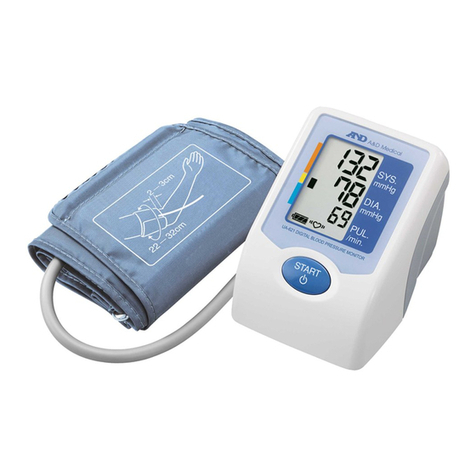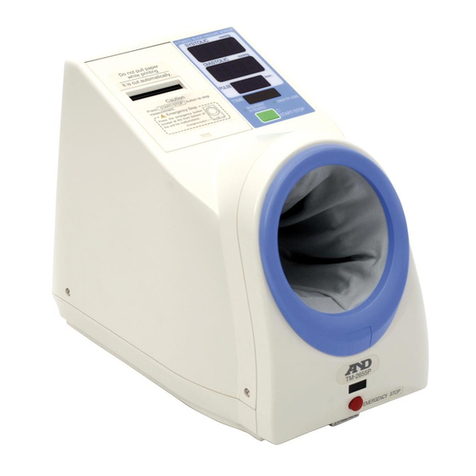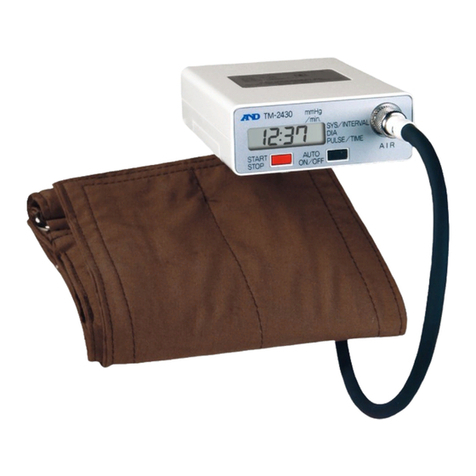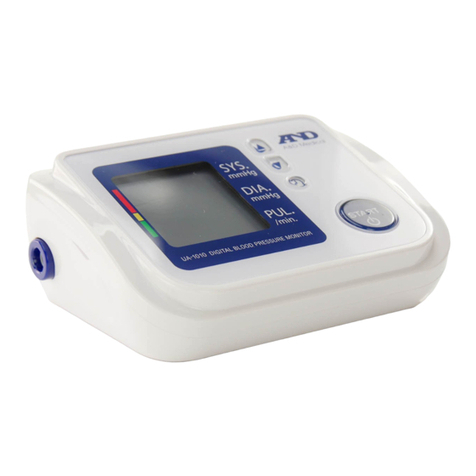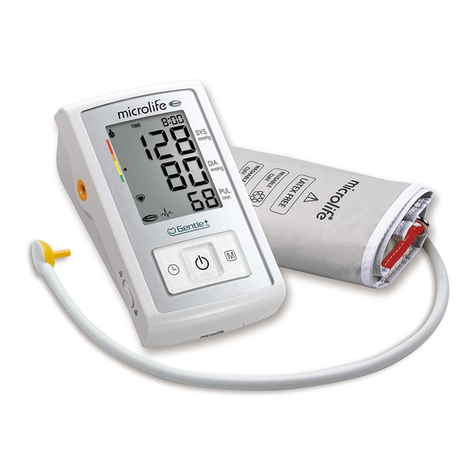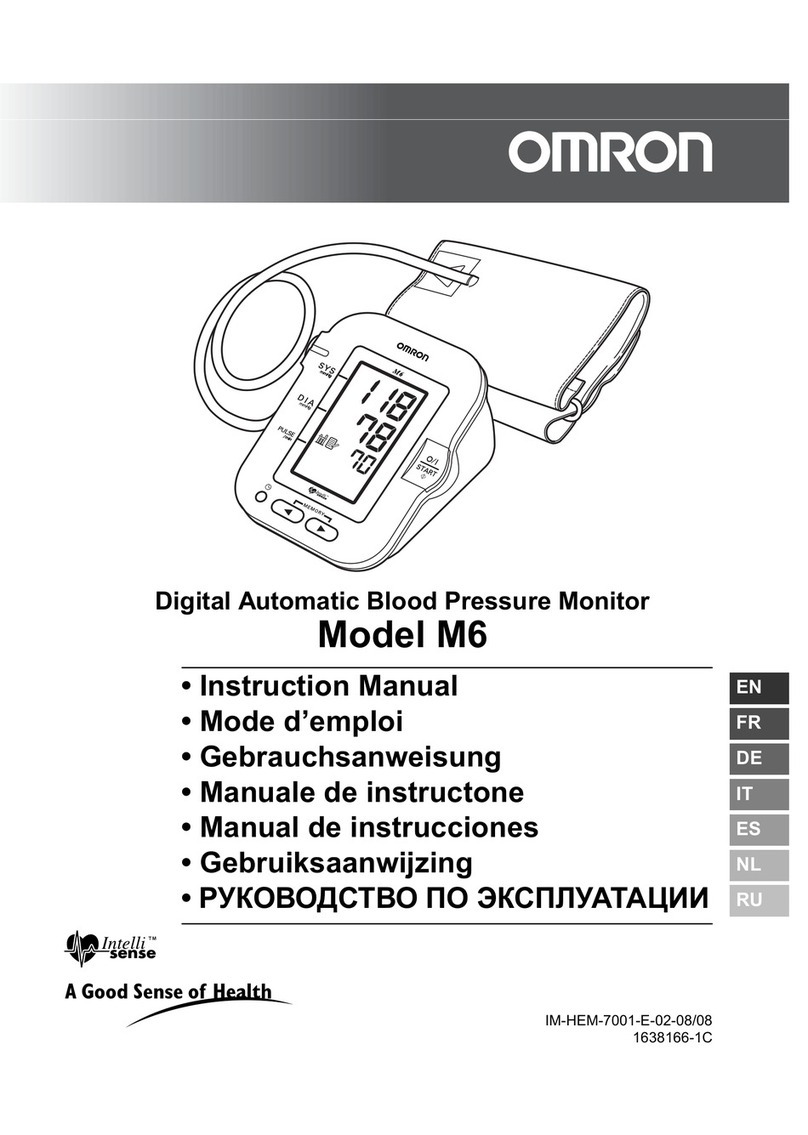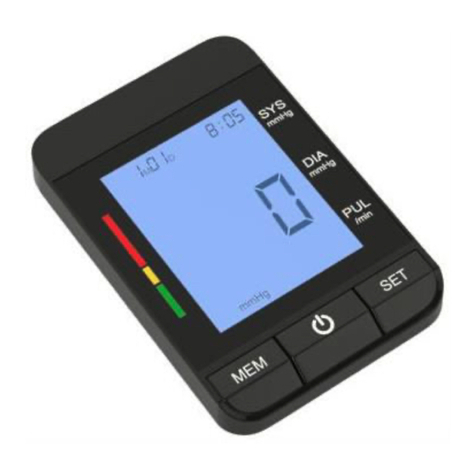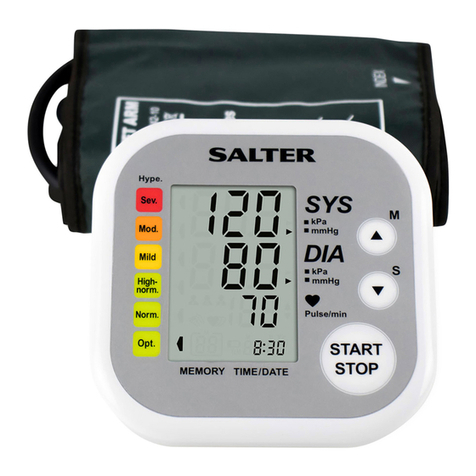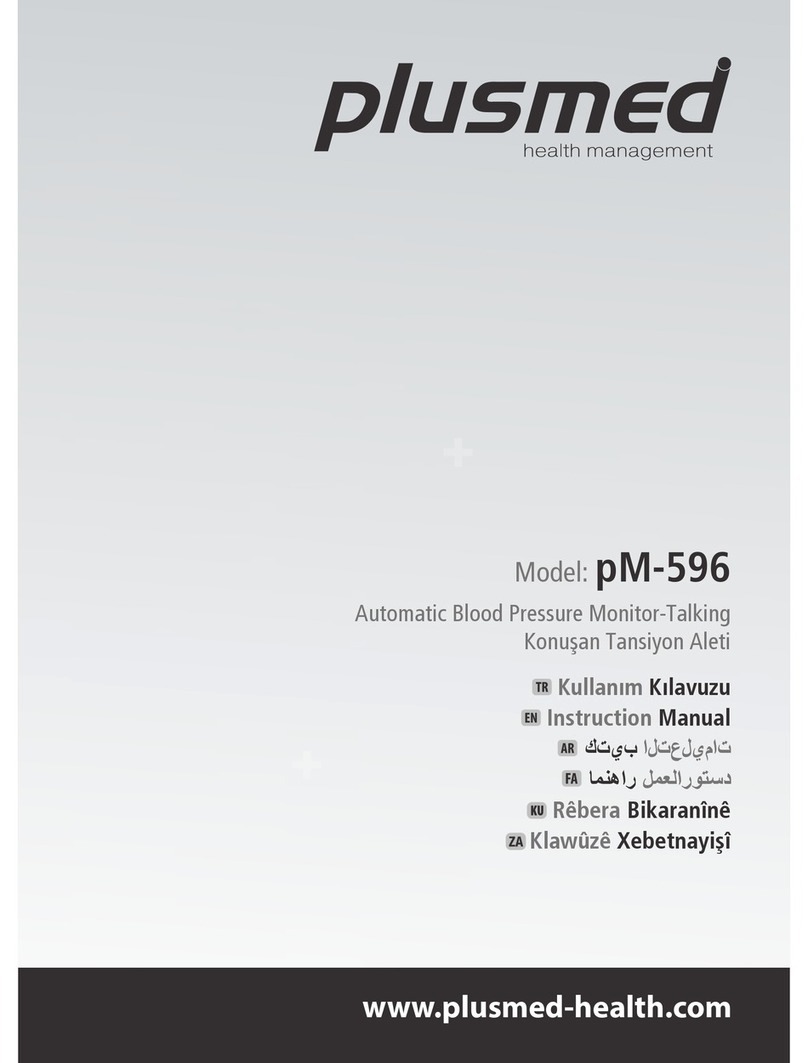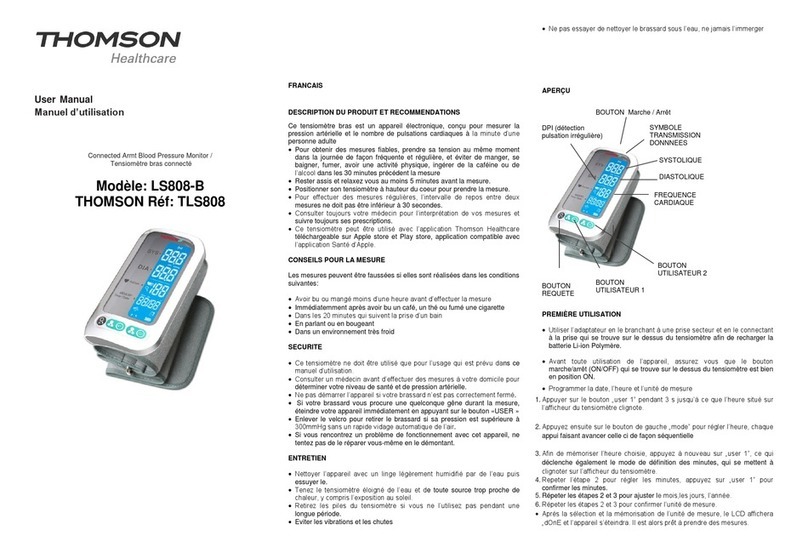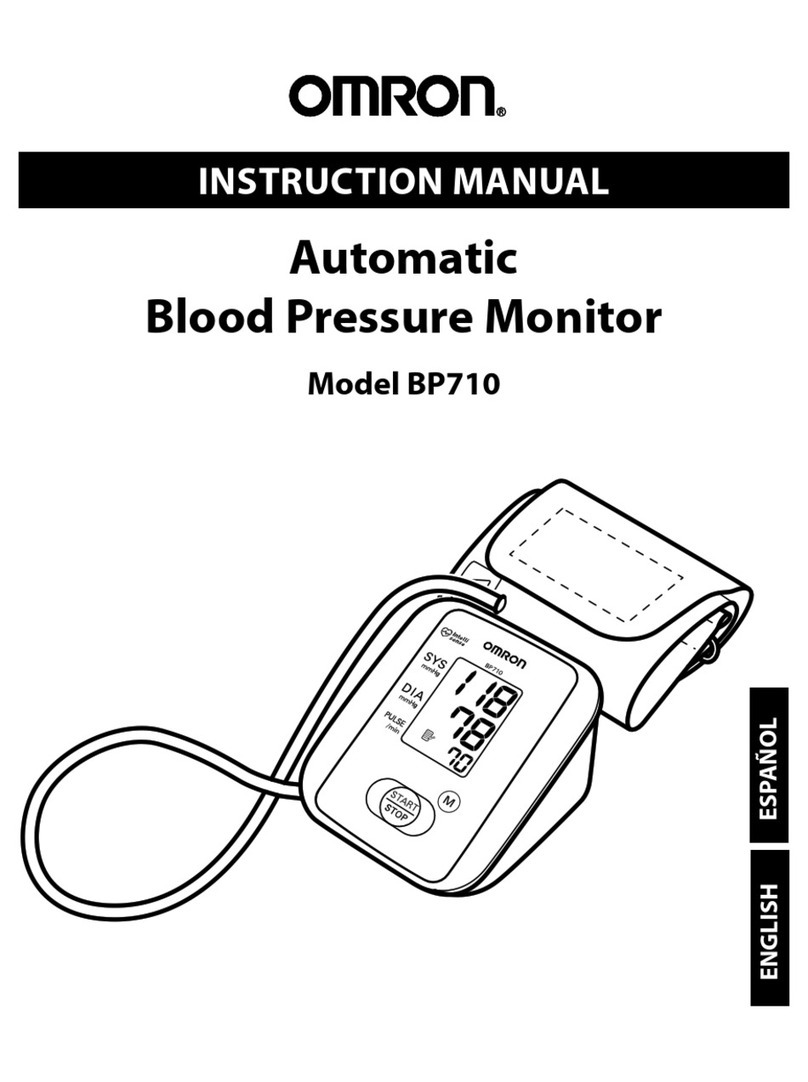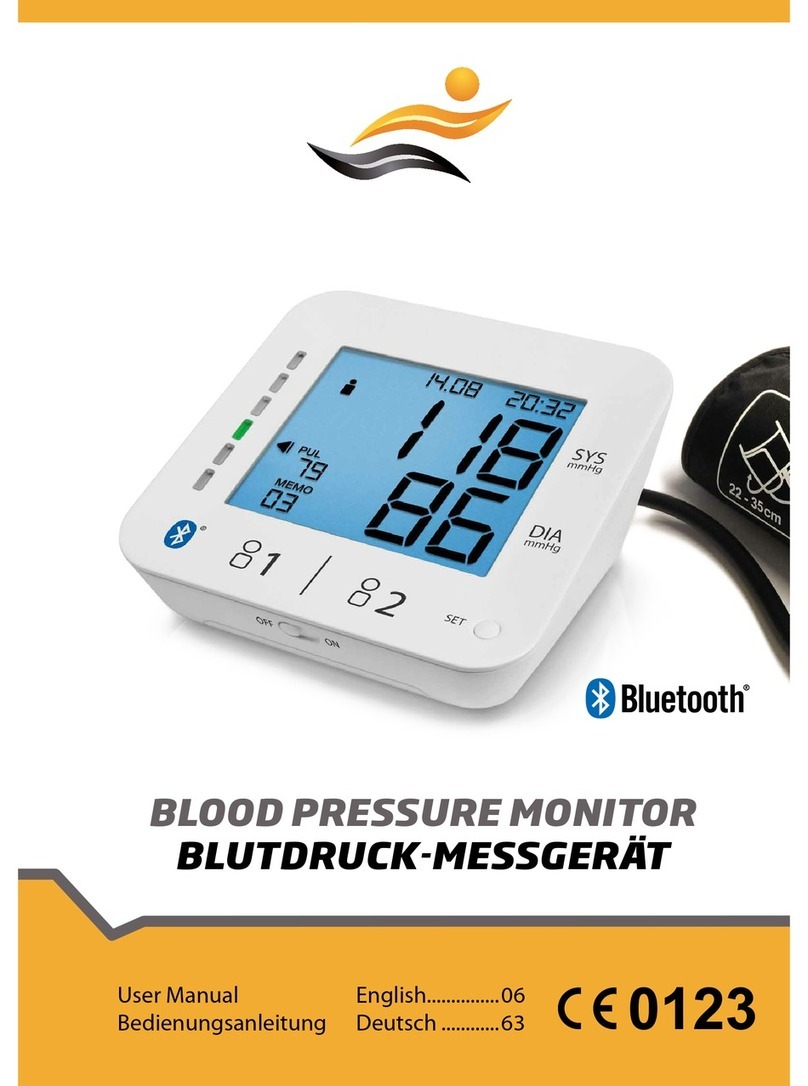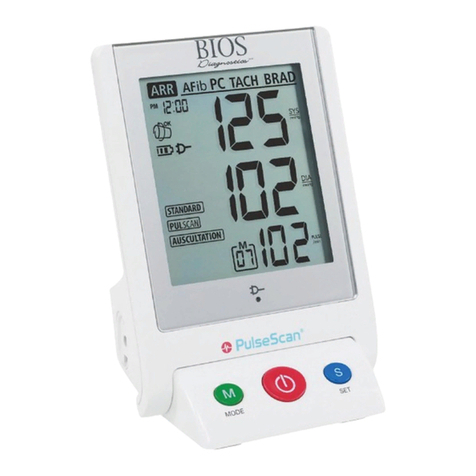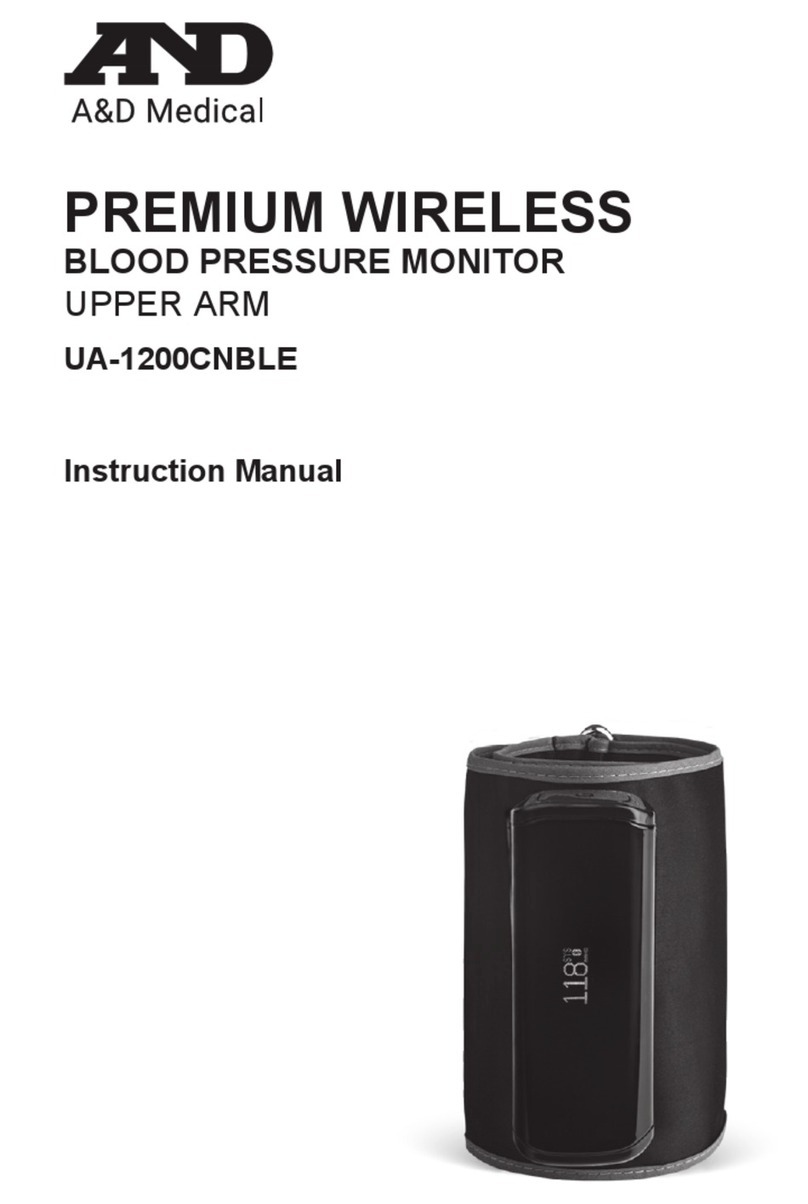AND UA-651BLE User manual

651 PROCONNECT
BLOOD PRESSURE MONITOR
UA-651BLE
Instruction Manual
ORIGINAL
1WMPD4003261

E-1
Greetings
This A&D blood pressure monitor is one of the most advanced
monitors available and is designed for ease of use and accuracy.
This device will facilitate your daily blood pressure regimen. We
recommend that you read through this manual carefully before
using the device for the rst time. The Bluetooth®word mark and
logos are registered trademarks owned by Bluetooth SIG, Inc. and
any use of such marks by A&D is under license. Other trademarks
and trade names are those of their respective owners.
Preliminary Remarks
qThe device complies with part 15 of the FCC rules and
contains the FCC ID VPYLBVZ.
qThe device is designed for use on adults only, and is not
intended for infants.
qThis device is designed for use in the home healthcare
environment to measure blood pressure and pulse rate of
people for diagnosis.
Precautions
qPrecision components are used in the construction of this
device. Extremes in temperature, humidity, direct sunlight,
shock or dust should be avoided.
qClean the device and cuff with a dry, soft cloth or a cloth
dampened with water and a neutral detergent. Never use
alcohol, benzene, thinner or other harsh chemicals to clean the
device or cuff.
qAvoid tightly folding the cuff or storing the hose tightly twisted
for long periods, as such treatment may shorten the life of the
components.
qThe device and cuff are not water resistant. Prevent rain, sweat
and water from soiling the device and cuff.

E-2
Precautions
qMeasurements may be distorted if the device is used close
to televisions, microwave ovens, cellular telephones, X-ray or
other devices with strong electrical elds.
qWhen using the device, conrm that the device is clean.
qUsed equipment, parts and batteries are not treated as
ordinary household waste, and must be disposed of according
to the applicable local regulations.
qWhen the AC adapter is used, make sure that the AC adapter can
be readily removed from the electrical outlet when necessary.
qDo not modify the device. It may cause accidents or damage to
the device.
qTo measure blood pressure, the arm must be squeezed by
the cuff hard enough to temporarily stop blood ow through
the artery. This may cause pain, numbness or a temporary red
mark to the arm. This condition will appear especially when
measurement is repeated successively. Any pain, numbness,
or red marks will disappear with time.
qTake care to avoid accidental strangulation of babies or infants
with the hose.
qDo not twist the air hose during measurement. This may cause
injury due to continuous cuff pressure.
qWireless communication devices, such as home networking
devices, mobile phones, cordless phones and their base
stations, walkie-talkies can affect this blood pressure monitor.
Therefore, a minimum distance of 11 feet (3.3 meters) should
be kept from such devices.
qMeasuring blood pressure too frequently may cause harm
due to blood ow interference. Check that the operation of
the device does not result in prolonged impairment of blood
circulation, when using the device repeatedly.

E-3
Precautions
qIf you have had a mastectomy, please consult a doctor before
using the device.
qDo not let children use the device by themselves and do not
use the device in a place within the reach of infants.
qThere are small parts that may cause a choking hazard if
swallowed by mistake by infants.
qDo not apply the cuff on an arm in which another medical
device is attached. The equipment may not function properly.
q People who have a severe circulatory decit in the arm must
consult a doctor before using the device, to avoid medical
problems.
qDo not self-diagnose the measurement results and start
treatment by yourself. Always consult your doctor for evaluation
of the results and treatment.
qDo not apply the cuff on an arm with an unhealed wound.
qDo not apply the cuff on an arm receiving an intravenous drip
or blood transfusion. It may cause injury.
qDo not use the device where ammable gases such as
anesthetic gases are present. It may cause an explosion.
qDo not use the device in highly concentrated oxygen
environments, such as a high-pressure oxygen chamber or an
oxygen tent. It may cause a re or explosion.
qThis device complies with Part 15 of FCC rules. Operation is
subject to the following two conditions: (1) This device may not
cause harmful interference, and (2) this device must accept
any interference received, including interference that may
cause undesired operations.

E-4
Table of Contents
Parts Identication E-6
Symbols E-7 - E-8
Using the Monitor E-9 - E-16
Measurement E-17 - E-19
What is an Irregular Heartbeat E-20
Pressure Bar Indicator E-20
Troubleshooting E-21
Maintenance E-22
Technical Data E-22 - E-25
Contact Information E-25
Warranty Information E-26 - E-28
?

E-5
Parts Identication
Display
W
Displa
y
A
ir Hose
Cuff
Button
Index
AirSocket
Proper fit range
Artery position mark
DC jac
k
AC adapter Plug
AirConnector Plug
Battery Compartment
Battery Cove
r
SystolicPressure
Diastolic Pressure
Battery Indicator
(Irregular
heartbeat symbol)
Pressure Bar Indicator
r
I.H.B. symbol
Communication mark
Heart Mark
START

E-6
Symbols
Symbols Function/Meaning Recommended Action
Appears while measurement is in
progress. It blinks when the pulse
is detected.
Measurement is in progress.
Remain as still as possible.
Irregular Heartbeat symbol
(I.H.B.) Appears when an
irregular heartbeat is detected.
It may light when a very slight
vibration like shivering or shaking
is detected.
––––––––––––
FULL BATTERY – The
battery power indicator during
measurement.
––––––––––––
LOW BATTERY
The battery is low when it blinks.
Replace all batteries with
new ones, when the indicator
blinks.
■Err
Unstable blood pressure
due to movement during the
measurement.
Take another measurement.
Remain still during the
measurement.
The systolic and diastolic values
are within 10 mmHg of each other.
Apply the cuff correctly, and
try the measurement again.
The pressure value did not
increase during ination.
The cuff is not applied correctly.
■EPulse display error. The pulse is
not detected correctly.
■Err
■E
Device internal error
Remove the batteries and
press the button, and then
install the batteries again. If
the error still appears, contact
the dealer.
■Err
■9
and are illuminated
alternately during communication

E-7
Symbols Function/Meaning Recommended Action
■Err
■10 Pairing has not been performed
correctly
Remove and re-insert the
batteries. Try pairing again.
■Err
■11
■Pr Pairing in progress ––––––––––––
SEtUnpairing in progress ––––––––––––
■End Pairing complete ––––––––––––
Symbols printed on the device case
Symbols Function/Meaning
Standby and turn the device on.
SYS Systolic blood pressure in mmHg
DIA Diastolic blood pressure in mmHg
PUL/min Pulse per minute
R6(LR6,AA) Battery installation guide
Direct current
Type BF: Device, cuff and tubing are designed to provide
special protection against electrical shocks.
IP International protection symbol
SN Serial number
Refer to instruction manual/booklet
Keep dry
Polarity of DC jack
BT Bluetooth Address
Symbols

E-8
Using the Monitor
Installing/Changing the batteries
1. Remove the battery cover.
2. Remove the used batteries from
the battery compartment when
changing them.
3. Insert new batteries into the
battery compartment as shown,
taking care that the polarities (+)
and (-) are correct.
4. Replace the battery cover. Use only R6P, LR6 or AA batteries.
CAUTION
qInsert the batteries as shown in the battery compartment. If
installed incorrectly, the device will not work.
qWhen (blinks on the display and the device indicates that
the battery needs to be replaced, replace all batteries with new
ones. Do not mix old and new batteries. It may shorten the
battery life, or cause the device to malfunction. Replace the
batteries two seconds or more after the device turns off.
qIf does not appear, then the batteries are completely
drained.
qThe battery life varies with the ambient temperature and may
be shorter at low temperatures. Generally, four new LR6
batteries will last approximately for one year when used twice
for measurement each day.
qUse the specied batteries only. The batteries provided with
the device are for testing the device performance and may
have a limited life.
qRemove the batteries if the device is not to be used for a long
time. The batteries may leak and cause a malfunction.
Step 1
Step 3
Step 4
Step 2

E-9
Using the Monitor
Connecting the Air Hose
Insert the air connector plug into the
air socket rmly.
Connecting the AC Adapter
Insert the AC adapter plug into
the DC jack. Then, insert the AC
adapter into an electrical outlet.
The AC adapter part # TB-233, is
sold separately.
qUse the specied AC adapter. (Refer to E-22)
qWhen disconnecting the AC adapter from the electrical outlet,
grasp and pull the AC adapter body out of the outlet.
qWhen disconnecting the AC adapter plug from the blood pressure
monitor, grasp and pull the AC adapter plug our of the monitor.
Wireless Function
qIn the unlikely event that this monitor causes radio wave
interference to a different wireless station, change the location
where this monitor is used or stop use immediately.
qBe sure to use in a location where visibility between the two
devices that you want to connect is good. The connection
distance is reduced by the structure of buildings or other
obstructions. In particular, connection may be impossible when
devices are used on either side of reinforced concrete.
qDo not use Bluetooth®connection in the range of a wireless
LAN or other wireless devices, near devices that emit radio
waves such as microwaves, in locations where there are many
obstructions, or in other locations where signal strength is
weak. Doing so may result in frequent loss of connection, very
slow communication speeds and errors.
Air Socket
A
ir Connector Plug
A
ir Hose
DC Jack
A
C adapter Plug

E-10
Bluetooth® Smart devices carry the Bluetooth®
logo mark.
Continua certified devices carry the Continua
logo mark.
Using the Monitor
qUsing close to an IEEE802.11g/b/n wireless LAN device
may cause mutual interference to occur, which may result
in reduced communication speeds or which may prevent
connection. In this case, switch off the power supply to the
device that is not being used, or use the monitor in a different
location.device that is not being used, or use the monitor in a
different location.
qIf the monitor does not connect normally when used near a
wireless station or broadcast station, use the monitor in a
different location.
qA&D Medical cannot accept liability for any damages incurred
due to impaired operation or data loss, etc. that occur through
the use of this product.
qThis product is not guaranteed to connect to all Bluetooth®
compatible devices.
Bluetooth®Transmission
This product is equipped with a Bluetooth®wireless function and
can connect to the following Bluetooth®devices.
Bluetooth®devices that can be connected:
• Continua certied devices
• iPhone, iPad, iPod ( iPhone 4S or later )
• Applications and devices that are compatible with Bluetooth 4.0
Each device needs an application to receive data. For connection
methods, refer to the manual for each device.

E-11
Using the Monitor
To connect with your mobile device - download and install the
“A&D Connect” app:
Follow the instructions in the app to connect.
Check the compatible device list as the following website.
http://www.wellnessconnected.jp/english/compatibility/
Connecting to a mobile device (Pairing)
A Bluetooth®device needs to be paired with this blood pressure
monitor in order to communicate with that device. If this monitor
is paired with a receiver device from the start, measurement data
is transmitted automatically to the receiver device each time a
measurement is made.
Tips for pairing
qBe sure to turn the power of all other Bluetooth®devices off
when pairing. Multiple devices cannot be paired at the same
time. If the receiver device cannot receive measurement data,
try pairing once again.
qCommunication is possible with one of the receiver devices. If
a second receiver device is paired, the device other than the
most recently connected device will be unpaired to enable the
new device to be paired.
qFollow the steps on the next page to pair the monitor with
a Bluetooth®compatible receiver device. Also refer to the
manual of the receiver device. Please use a pairing wizard if
one is provided.

E-12
Using the Monitor
Pairing procedure
1. Follow the instructions in the manual of the receiver device to
switch it to the pairable status. When pairing this monitor, place
it as close as possible to the receiver device to be paired with.
2. Install the batteries or connect the AC adapter.
Press and hold the "START" button until "Pr" is
displayed, then release the button.
The monitor will be in a state that can be found by
the receiver device for about one minute.
3. The monitor displays "End" to indicate that pairing is
complete.
4. If "Err 10" is displayed or pairing is failed, remove the
batteries or disconnect the AC adapter and try steps
1-3 again.
5. Follow the manual of the pairing receiver device to search for,
select and pair with this monitor.
Communication Distance
The communication distance between this monitor and the
receiver device is about 33 feet (10 m). This distance is reduced
by the conditions in the surrounding environment, so be sure to
check that the distance is short enough for a connection to be
made after measurement is complete.

E-13
Using the Monitor
Transmitting Temporarily Stored Data
In cases when the receiver device cannot receive measurement
data, the measurement data is temporarily stored in the monitor
memory. The data stored in the memory is transmitted the next
time a connection is successfully made to the receiver device.
A total of 30 sets of measurement data can be stored. When the
amount of data exceeds 30 sets, the oldest data is deleted and
the new data is stored.
Time
This monitor has a built-in clock. The date and time a measurement
was taken is included in the measurement data. The built-in clock is
designed to be automatically adjusted by syncing with the clock of
a receiver device. Refer to the specications of the receiver device.
This monitor has no clock adjustment function.
Selecting the correct cuff
Using the correct cuff size is important for an accurate reading. If
the cuff is not the proper size, the reading may yield an incorrect
blood pressure value.
The arm size is printed on each cuff.
The index p and proper t range, on the cuff, tell you if you are
applying the correct cuff. Refer to "Applying The Arm Cuff".
If the index ppoints outside of the range, contact your local dealer
to purchase a replacement cuff.
The arm cuff is a consumable. If it becomes worn, purchase a
new one.

E-14
Using the Monitor
Arm size Recommended Cuff Size Part Number
8.6"-16.5" (22 to 42cm) AccuFit™ Plus cuff UA-420
9.0"-14.6" (23 to 37cm) Medium SlimFit™ UA-290
12.2"-17.7" (31 to 45cm) Large SlimFit™ UA-291
Arm size: The circumference at the biceps.
Note: Model UA-651BLE is not designed to use a small cuff.
Symbols that are printed on the cuff
Symbols Function/Meaning Recommended Action
lArtery position mark Set the lmark on the artery of the
upper arm or in line with the ring
nger on the inside of the arm.
pIndex ––––––––––––
REF Catalog number ––––––––––––
MProper t range for the medium
cuff. It's printed on the cuff. ––––––––––––
LOver range printed on the medium
cuff and AccuFit Plus cuff. Use the large cuff instead of the
medium cuff or the AccuFit™ Plus
cuff.
WProper t range for the AccuFit™
Plus cuff. It's printed on AccuFit™
Plus cuff.
LProper t range for the large cuff.
It's printed on the large cuff and
AccuFit™ Plus cuff. ––––––––––––
SUnder range printed on the medium
cuff and AccuFit™ Plus cuff. ––––––––––––
MUnder range printed on the large
cuff. Use the medium cuff instead of the
large cuff.
LOT Lot number ––––––––––––
S
M
AccuFitTM Plus cuff
Large cuff
W
S
Medium cuff
M

E-15
Using the Monitor
Applying the arm cuff
1. Wrap the cuff around the upper arm, about 0.5" (1-2 cm) above
the inside of the elbow, as shown.
Place the cuff directly against the skin, as clothing may cause a
faint pulse and result in a measurement error.
2. Constriction of the upper arm, caused by rolling up a
shirtsleeve, may prevent accurate readings.
3. Conrm that the index p points within the proper t range.
Note: During measurement, it is normal for the cuff to feel very tight. (Do not be alarmed).
≈ 0.5”(1-2 cm)

E-16
Measurement
Normal Measurement
1. Place the cuff on the arm
(preferably the left arm). Sit
quietly during measurement.
2. Press the START button. All
of the display segments are
displayed. Zero is displayed
blinking briey.
Then the display changes, as
indicated in the gure to the right,
as the measurement begins.
The cuff starts to inate. It is
normal for the cuff to feel very
tight. A pressure bar indicator is
displayed, as in the gure to the
right, during ination.
Note: If you wish to stop ination at any time, press
the START button again.
3. When ination is complete,
deation starts automatically
and the (heart mark) blinks,
indicating that the measurement
is in progress. Once the pulse
is detected, the mark blinks with
each pulse beat.
Note: If an appropriate pressure is not obtained, the
device starts to inate again automatically.
4. When the measurement is complete, the systolic and diastolic
pressure readings and pulse rate are displayed. The cuff
exhausts the remaining air and deates completely.
5. Press the START button again to turn off the power.
Note: This product is provided with an automatic power shut-off function, which turns the
power off approximately one minute after measurement.
At heart level
All of the display
segments
Press the START button
Zero display
Starts ination
Pressurizing
Turn o with the
START button

E-17
Measurement
Measurement with the Desired Systolic Pressure
If re-ination occurs repeatedly, use
the following methods. If your systolic
pressure is expected to exceed
230 mmHg, use this procedure.
1. Place the cuff on the arm at heart
level (preferably the left arm).
2. Press the START button.
3. During the zero blinks, press and
hold the START button until a
number about 30 to 40 mmHg
higher than your expected systolic
pressure appears.
4. When the desired number is
reached, release the START
button to start measurement. Then
continue to measure your blood
pressure as described on the
section "Normal Measurement".
Notes for Accurate Measurement
qSit down in a comfortable position. Place the arm to be used
for the measurement on a table or other support so that the
center of the cuff will be at the same height as your heart.
qRelax for several moments before measurement.
qRemove constricting clothing and place cuff on bare arm.
qUnless your physician recommends otherwise, use left arm to
measure pressure.
qDo not talk during measurement.
Press the
START button
All of the display
segments displayed
At heart level
Press and hold the
START button
Inflation in progress
Refer to the section
“Normal Measurement”
Release the START
button to stop inflation
Desired pressure

E-18
Measurement
qDo not measure immediately after physical exercise or a bath.
qDo not smoke or ingest caffeine at least 30 minutes prior to
measurement.
qThis device bases its measurements on the heartbeat. If you
have a very weak or irregular heartbeat, the device may have
difculty determining your blood pressure.
qShould the device detect a condition that is abnormal, it will
stop the measurement and display an error symbol. Refer to
the section "Symbols" for the description of the symbols.
qThis device is intended for use by adults only. Consult with
your physician before using this device on a child. A child
should not use this device unattended.
qCompare blood pressure taken at the same time each day.
qDo not cross legs and keep your feet at on the oor during
measurement.

E-19
What is an Irregular Heartbeat
The UA-651BLE provides a blood pressure and pulse rate
measurement even when an irregular heartbeat occurs. An
irregular heartbeat is dened as a heartbeat that varies by 25%
from the average of all heartbeats during the blood pressure
measurement. It is important that you are relaxed, remain still and
do not talk during measurements.
Note: We recommend contacting your physician if you see this symbol frequently.
Pressure Bar Indicator
The indicator monitors the progress of pressure during
measurement
Pressurizing Releasing air
Measurement in progress
Inflation complete
Inflation in progress
Other manuals for UA-651BLE
2
Table of contents
Languages:
Other AND Blood Pressure Monitor manuals
